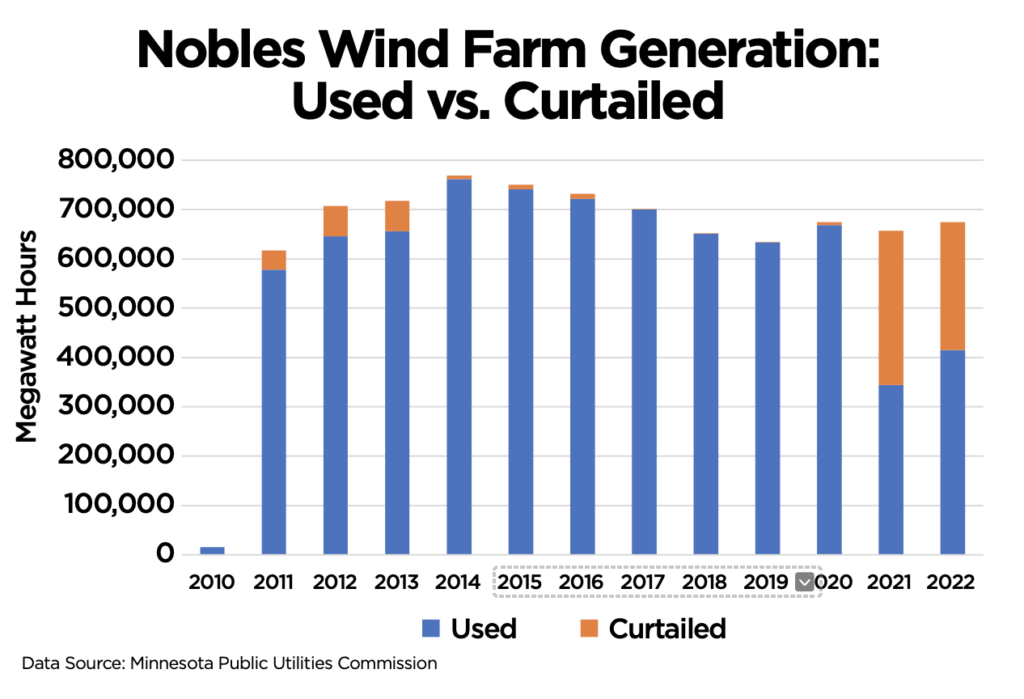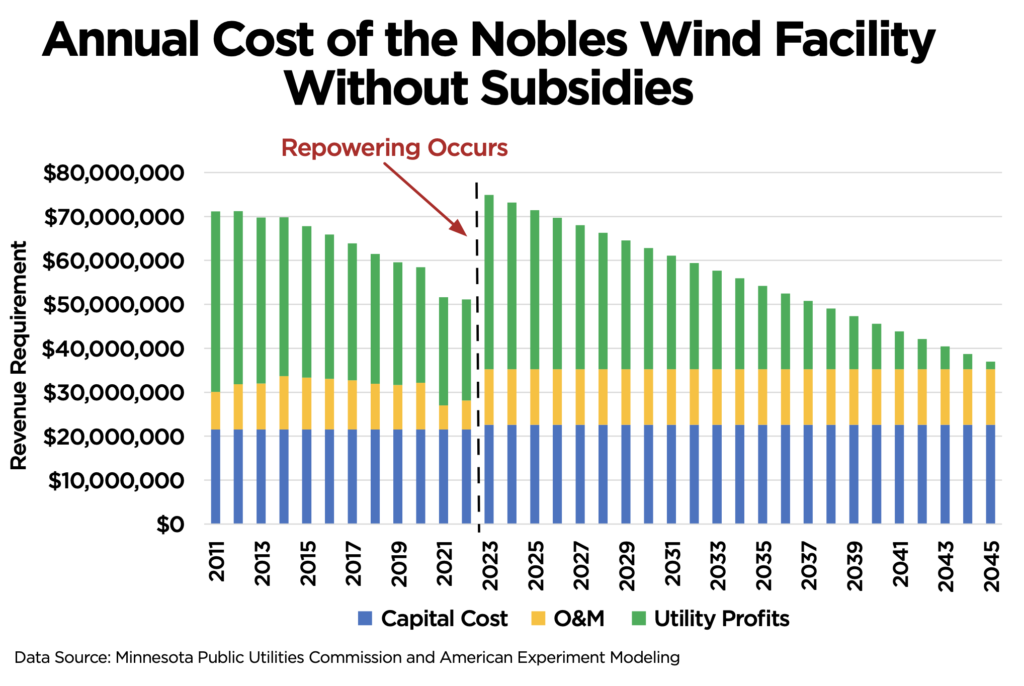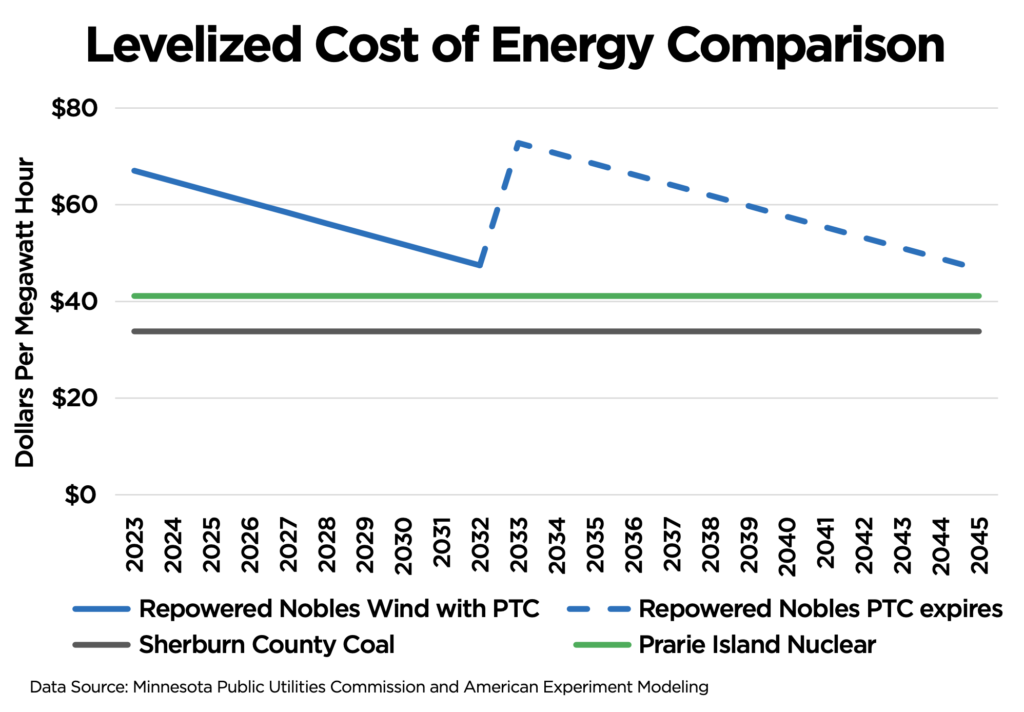The death of a wind farm
Why the United States is No Country for Old Wind.
What can one wind facility in Southwestern Minnesota tell us about the state of the American electric grid? Quite a lot, actually.
In 2007, Minnesota began its quest to power the state with wind turbines and solar panels when the Next Generation Energy Act (NGEA) was signed into law, which mandated that 25 percent of the state’s electricity come from “renewable” energy sources by 2025.
These mandates, along with generous federal tax subsidies and monopoly utilities seeking to maximize their government-approved profits by building new infrastructure, led to a building boom in wind turbines and solar panels. From 2007 through 2021, Minnesota built thousands of wind turbines totaling 3,555 megawatts (MW) of installed capacity, and 1,093.5 MW of solar capacity en route to meeting the mandates in 2020, five years ahead of schedule.
However, many of the turbines built to comply with the 25 percent mandate are already being refurbished or “repowered,” long before the end of their supposed 25-year useful lives. In fact, one of these wind facilities, the Nobles wind farm, has already been repowered after just 12 years in service.
But why was Nobles refurbished more than a decade before the end of its useful life at a cost of $240 million? The official reason provided by Xcel Energy for repowering Nobles was to spur economic activity in the wake of the COVID-19 pandemic and extend the retirement date of the facility from the year 2035 to 2045.
This story makes for a good newspaper headline, but the data tell a very different story. Digging deeper into the reasons surrounding Xcel’s decision to repower the Nobles facility illustrates how our state and federal energy policies are causing America’s energy decisions to grow increasingly irrational.
What is repowering and why does it occur?
To fully understand the depth and gravity of this situation and why it has a profound impact on energy policy moving forward, it’s helpful to take a closer look at what repowering is, and why it is done.
Repowering is the process of retrofitting or replacing wind turbines in full (full repowering), or in part (partial repowering). Full repowering is the act of completely decommissioning smaller existing wind turbines at a facility and replacing them with larger, but typically fewer, wind turbines.
Partial repowering is the most common form of repowering, and it consists of replacing portions of old turbines, such as the gearbox, hub, main shaft, bearing assembly, rotor, and blades, while maintaining the original steel towers and concrete foundations.
New gearboxes can be needed because the bearings responsible for converting the relatively slow rotations of a turbine’s blades into the high speeds needed to generate electricity can develop cracks, reducing the wind turbine’s efficiency. Larger rotors and longer blades are frequently placed on the original steel towers to increase the wingspan of the wind tower, thus allowing it to access more wind energy and convert it to electricity.
All of these actions help increase the productivity of wind turbines, but the biggest reason that companies seek to repower wind turbines has nothing to do with how they perform and everything to do with money. Repowering wind projects allows them to requalify for the wind Production Tax Credit (PTC), a lucrative federal subsidy that expires after the first 10 years of a project’s life.
It should come as no surprise, then, that data from the U.S. Department of Energy shows that the wind facilities repowered in 2021 ranged in age from 9 to 16 years old with the median age being 10 years. In essence, the lucrative federal subsidies paid to wind turbine operators are creating a perverse incentive to prematurely refurbish or replace wind projects long before the end of their useful lifetimes, including the Nobles wind project in Minnesota.
Nobles: promises made
Nobles is a 201-megawatt (MW) wind facility consisting of 134 turbines spanning 26,880 acres just outside of Reading, Minnesota — about 45 miles east of the South Dakota border. Construction of the wind “farm” cost $538 million (in 2010 dollars) and it began commercial operation in December 2010.

According to documents filed by Xcel Energy to the Minnesota Public Utilities Commission (PUC), the project was supposed to produce 40.9 percent of its potential energy output — a metric known as its “capacity factor” — every year over the course of an assumed 25-year lifetime.
From 2011 through 2020, Nobles did a relatively good job of meeting Xcel’s expectations, producing an average output of 38.2 percent of its theoretical potential during these years. But things changed in 2021 when the annual capacity factor of Nobles plummeted to 19.5 percent, and it performed only moderately better in 2022, with a capacity factor of 23.6 percent. These down years brought the 12-year average capacity factor of the facility down to 35.4 percent, which you can see in the accompanying graph.
But why did electricity generation at Nobles fall so dramatically in 2021 and 2022 when the Nobles 2 wind project, a newer, larger wind project which is located just six miles to the northwest of the original Nobles, had a capacity factor of 42.7 percent in 2021, and 49.9 percent in 2022? The answer illustrates how federal subsidies and state mandates are incentivizing the construction of so many wind turbines that the energy produced by them is often wasted.
Lost in transmission
Nobles is located in a very windy part of the state, which prompted the construction of dozens of wind facilities nearby to meet Minnesota’s renewable energy mandate and to maximize the generation of electricity and federal tax credits.
Currently, there aren’t enough transmission lines to move the power generated from these wind facilities to other areas of the 15-state regional grid that could use it. As a result, the oversupply of electricity frequently causes power prices to go negative, which sends a signal to wind turbine operators to scale back supply — at least in theory.
In reality, the PTC pays wind projects $26 for each MWh of electricity the facility produces, whether or not that electricity is needed. The subsidies mean that electricity generated from wind farms could potentially be sold into the market at a price of negative $25 per MWh and still turn a profit for their owners.
Without the subsidies, however, wind turbine operators are forced to reconcile with the realities of supply and demand because selling wind generation at negative prices would lead to substantial losses. This causes the turbine operator to shut the wind turbine down — an industry process called curtailment — when wind generation is high but wholesale power prices are low in an effort to avoid losing money.
Data from Minnesota PUC filings show a large increase in curtailment at Nobles in 2021 when 47.6 percent of the potential output from Nobles was curtailed, and in 2022 when curtailment rates reached 38 percent, as shown in the first graph.

The spike in curtailment is important to understand because it suggests that wind facilities around the country are at risk of becoming uneconomical once the PTC expires after 10 years, long before the 20 to 25 years that are commonly cited as their useful lifetimes.
Wind advocates argue that we need to spend billions of dollars building hundreds of miles of new transmission lines — which routinely cost $2.5 million per mile — to transport larger quantities of wind-generated electricity to reduce the amount of wind power that is ultimately wasted.
However, this solution would be temporary, at best, because the availability of federal subsidies would once again distort the market and encourage utility companies to build an excess of wind facilities in an area where there isn’t adequate transmission capacity. In the end, we would end up in the same situation after spending more money at great cost to taxpayers and ratepayers in Minnesota.
Costs to consumers: Is repowering a bait and switch?
When Xcel Energy proposed its Nobles repowering project to the Minnesota PUC, the company claimed that customers would benefit from this and six other repowering projects by saving $160 million in energy costs over the next 25 years. But the biggest beneficiary of the Nobles repowering project was Xcel Energy because repowering means the company will earn millions of dollars in profits for their shareholders at taxpayer expense.
Because investor-owned utilities like Xcel Energy are regulated monopolies created by the state of Minnesota, they are not allowed to make a profit on the electricity they sell. Instead, they are only allowed to charge enough to cover the cost of providing electricity everyone, plus a government-approved 10.2 percent profit, or rate-of-return on equity, when they spend money on capital assets such as new power plants, transmission lines, and even new corporate offices, so long as the PUC approves those expenses. However, the 10.2 percent profit declines every year as the capital assets depreciate or lose value over time. This gives Xcel a powerful incentive to spend millions of dollars building as many wind turbines as possible, and to spend millions more repowering them long before the end of their useful lifetime.
The second graph shows the unsubsidized annual cost of the Nobles wind facility from 2011 through 2045, depicting the yearly cost of the project before and after the repowering. As is illustrated, the total annual cost of the project jumps from around $51 million in 2022, to $74.8 million in 2023 after repowering. Xcel’s profits constitute the largest cost increase, rising from $22.9 million in 2022, to $39.6 million in 2023, a substantial dividend of $16.7 million that year.

We present the unsubsidized annual cost of the Nobles project because subsidies don’t change the cost of a good or service, they simply change who pays for it. In this instance, federal taxpayers, or future generations, are picking up part of the tab on behalf of Xcel Energy’s customers.
Our analysis did find that repowering the Nobles facility to requalify for the tax credit and extend the “book” life of the facility by 10 years would slightly reduce the cost per MWh at Nobles for Xcel’s ratepayers compared to allowing the facility to run at lower capacity factors due to curtailment and allowing the subsidies to expire. That is, only if the facility operates for the “expected” 25 years this time.
However, we also concluded that even the subsidized cost of the repowered Nobles project would never be lower than the cost of generating electricity at the Sherburne County (Sherco) coal plant or the Prairie Island nuclear plant, which produced electricity for $38.80 per MWh and $41.13 per MWh, respectively, as illustrated in the third graph. This is because the PUC allowed Xcel to continue earning profits on the original assets that were replaced through 2045.
Nobles would theoretically cost less than Prairie Island in 2034, but the PTC would expire after 2032, and Nobles would go back to being 75 percent more expensive than the existing nuclear plant.
These concepts are complex, but they are not impossible to understand. Unfortunately, it appears the five commissioners on the Minnesota PUC — all of whom were either appointed or reappointed by Gov. Tim Walz — do not seem to understand that voting to approve the repowering of the Nobles wind facility would increase electricity costs to Minnesota families and businesses compared to encouraging Xcel Energy to run the Sherco plant more frequently.
If the PUC commissioners were interested in protecting ratepayers from Xcel Energy’s bait-and-switch tactics and holding electricity prices to the standard of the “just and reasonable” clause in Minnesota statutes, they would question Xcel Energy’s perpetual money machine of building wind turbines and repowering them long before their 20-to-25-year useful lives. Instead, all five rubber-stamped the Nobles repowering project and the associated costs.
Final thoughts: What Nobles means for America
The life, premature demise, and repowering of the Nobles wind facility suggests the United States is No Country for Old Wind, and Nobles is no anomaly.
Data from the U.S. Department of Energy show 30,000 MW of wind capacity will have been repowered by 2026, which would constitute 21.4 percent of the total wind capacity installed nationwide in 2022. It also isn’t unreasonable to think that the Nobles and other wind facilities will undergo another round of full or partial repowering if the federal subsidies are still available in 2032.
Taxpayer subsidies and utility profit motives are converging to incentivize the premature destruction and replacement of wind installations throughout America, and this trend will almost certainly become more common as an increasing number of wind turbines are added to the nation’s electric grid. Utility companies and wind turbine operators will seek to renew their access to the PTC to reduce the need for curtailment and to increase their government-approved profits on capital expenditures, as long as these subsidies are available.